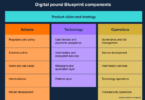Highlights
- Initial digital dollar use cases: remittances and financial inclusion, cross border payments, low cost SME retail payments
- Distributed via two-tier banking system as most practical, efficient route
- Use distributed ledger technology
- As world’s reserve currency, important to get it right rather than be first
This week the concept of a digital dollar hit the headlines as the U.S. Democrats floated the idea of electronically distributing COVID-19 stimulus money to the unbanked. However, there is already a quite different Digital Dollar Project initiated by former Commodity Futures Trading Commission (CFTC) Chair Chris Giancarlo that’s exploring the potential for a U.S. central bank digital currency (CBDC) in partnership with Accenture.
David Treat, co-Lead of Accenture’s Blockchain Business and a Director of the Digital Dollar Project, spoke to Ledger Insights about the initiative, which aims to create a public-private partnership to come up with a design suitable for the U.S.
In the context of the COVID-19 crisis, given the urgency of getting funds to those in need, is a CBDC a practical option?
“It is not something that can be done in weeks,” said Treat. “We’re at the beginning of this journey in terms of what we’re calling a digital dollar.” And Accenture should know because it has been consulting central banks on the topic for years, including in Canada, Singapore, Sweden and Europe.
However, while the timing may be off, Treat commented that a modern form of the dollar would help to better respond to crises like the current one.
A digital dollar can mean many different things. The Digital Dollar Project defines it as a tokenized form of central bank digital currency that would be distributed via the two-tier banking system. Treat described it as “having it (dollars) be minted, if you will, through the Fed and Treasury, and then distributed out to the commercial bank infrastructure, to then be distributed onwards to retail endpoints.”
“Being able to operate within the current structures is vastly more efficient and practical,” said Treat.
Not everyone believes that distributed ledger technology (DLT) is needed to implement a CBDC, and some think it’s not sufficiently scalable. While Accenture is open to evaluating all options, Treat favors DLT. “That ability to have a unique object in the digital world. The notion of a shared ledger to be able to have that control and confidence and auditability and transparency, according to the policies of the ecosystem, are all incredibly powerful. And seem to be the right answer,” said Treat.
Coming back to the potential for a framework, it will also include addressing digital identity and the wallet infrastructure to store the digital currency.
A digital dollar for remittances, financial inclusion
At a high level, the purpose of a digital dollar is to make sending money as easy as sending a text or photo.
In terms of applications, an important one is remittances for foreign workers sending money home. The World Bank figures show an average remittance cost of 6.8%. Treat commented that “it can be as much as the high teens or even in extreme cases, 20% or more. This is charging an exorbitant fee to the people who can least afford to pay it.”
Ledger Insights found the World Bank figures show a huge variation in fees, with online transactions to some destinations quite cost-effective. By comparison, transfers involving physical cash and visiting a money transfer company are expensive.
Treat pointed to the frequent lack of a bank account requiring the use of cash. And access to bank accounts is linked to identity and having a fixed place to live. “So addressing the digital literacy and financial literacy aspects is absolutely important,” said Treat. “(But) the whole notion of digital identity is incredibly important to participate fully in our financial ecosystem.”
He pointed to other countries that have centralized digital identity systems but doesn’t see that happening in the U.S.
“The focus from a financial inclusion perspective is, how do you get effective digital identity into the hands of those with none? And how do you, through education and access, enable those that have an identity but no direct access to the financial system, to get one?” asked Treat.
He continued: “How do you employ mechanisms that we’ve used for things like food stamps and other benefits distribution approaches to reach those people that currently don’t participate directly in the financial infrastructure?”
In terms of use cases, remittances are the smaller end of cross border payments, but there are also challenges for larger transactions.
Use cases for cross border payments, SME retail payments
The problems with cross border payments are well-documented and include the need for intermediary banks where a bank doesn’t have an account at the payment destination. The multi-hop payments are expensive and slow things down, especially if there’s a query. “It is also incredibly costly and inefficient,” said Treat.
Several solutions aim to address the status messaging issues, including RippleNet, SWIFT’s gpi and JP Morgan’s Interbank Information Network.
But with tokenized central bank money, the transfer is direct and there’s no need to maintain numerous accounts around the world.
A third use case relates to small retailers that invariably accept cash and cards. But as more retail moves online, cards are the primary option and carry relatively high fees. And small business owners are less able to afford these charges. From a consumer perspective, a digital token might not appear much different to using Zelle or Venmo but potentially could significantly cut fees for SME retailers.
The Digital Dollar project has just announced a 22 member advisory board and, notably, both Visa and Mastercard are represented.
While the use cases seem compelling, the big question is whether there’s an appetite for digital currency.
Is there demand?
Treat noted that from a central bank perspective, there has been a dramatic uptick in interest in the past year. Perhaps that’s driven in part by Facebook’s Libra. A BIS survey of central banks confirms this elevated enthusiasm.
But the other side of the equation is consumers. OMFIF and Ipsos MORI recently conducted a survey of citizens across 13 nations. Asia demonstrated a far bigger appetite for digital currencies compared to the West. And it’s favored more by younger, wealthier males.
In the vast majority of countries, the central bank was the preferred issuer of digital currency. But not in the U.S. where payment processors such as Paypal or Apple pipped the Federal Reserve. Although for both the payment firms and the central bank, more survey respondents were negative rather than positive. And for a CBDC, the only country with a more negative sentiment than the U.S. was Italy.
Despite these results, it’s a reasonable question to ask whether the average survey respondent understands the difference between a stablecoin and a Central Bank Digital Currency.
Digitizing the world’s reserve currency
While the requirements of a central bank digital currency are unique to every country, the fact that the U.S. dollar is the world’s reserve currency makes it more important.
“The usefulness of having a dominant reserve currency and the consistency and stability that drives on a global basis has been quite helpful in the development of how our globally interconnected financial system has worked.”
A digital dollar offers massive potential benefits in trade and financial markets but also risks for other economies if non – U.S. citizens decide to hold U.S. dollars en masse.
Recognizing this, Treat said: “part of our focus is to move, slowly and deliberately. There is no need to move fast and be first. We want to make sure that we get it right.”






